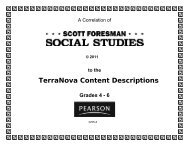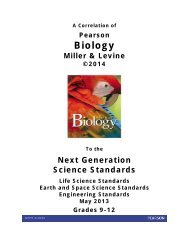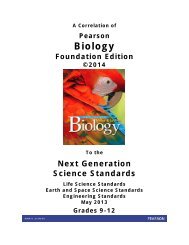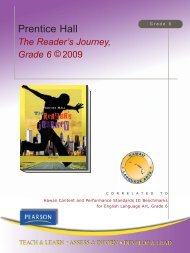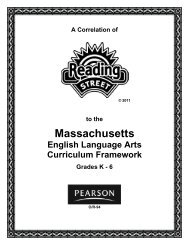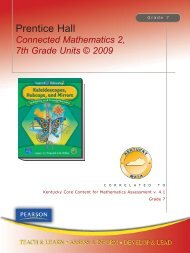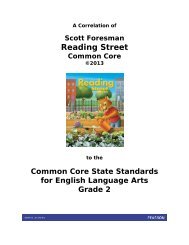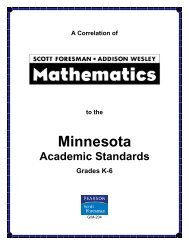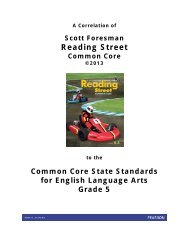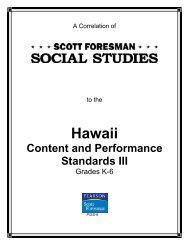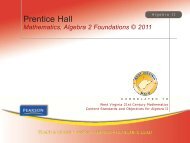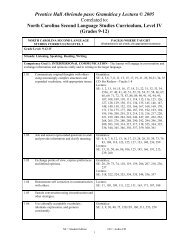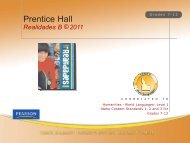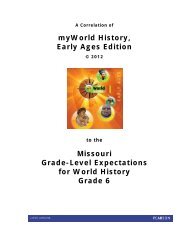Prentice Hall Science Explorer â 16 Book Series © 2009 ... - Pearson
Prentice Hall Science Explorer â 16 Book Series © 2009 ... - Pearson
Prentice Hall Science Explorer â 16 Book Series © 2009 ... - Pearson
You also want an ePaper? Increase the reach of your titles
YUMPU automatically turns print PDFs into web optimized ePapers that Google loves.
<strong>Prentice</strong> <strong>Hall</strong> <strong>Science</strong> <strong>Explorer</strong> – <strong>16</strong> <strong>Book</strong> <strong>Series</strong> © <strong>2009</strong><br />
Correlated to:<br />
Connecticut Core <strong>Science</strong> - Content Standards and Expected Performances<br />
(Grades 6-8)<br />
CONNECTICUT CORE SCIENCE - CONTENT<br />
STANDARDS AND EXPECTED<br />
PERFORMANCES<br />
The motion of the Earth and moon relative to<br />
the sun causes daily, monthly and yearly<br />
cycles on Earth.<br />
Expected Performances<br />
C28. Explain the effect of gravity on the<br />
orbital movement of planets in the solar<br />
system.<br />
PAGE(S) WHERE TAUGHT<br />
(If submission is not a text, cite<br />
appropriate resource(s))<br />
Astronomy<br />
SE/TE: 4-15, <strong>16</strong>-19, 20-29; At Home<br />
Activity: 27; Chapter Project: 5; Discover<br />
Activity: 6, <strong>16</strong>, 20; Key Terms: 6, <strong>16</strong>, 20;<br />
Math Analyzing Data: 18; <strong>Science</strong> and<br />
History: 8-9; Skill Activity: 24; Skill Lab: 14-<br />
15, 28-29; Target Reading Skills: 6, <strong>16</strong>, 20;<br />
Try This Activity: 10; Writing in <strong>Science</strong>: 9,<br />
19<br />
TE: Address Misconceptions: 4G, 12;<br />
Background: 8; Build Inquiry: 10, 12, 22;<br />
Differentiated Instruction: 7, 9, 11, 17, 21,<br />
23, 25; Monitor Progress: 7, 9, 11, 13, 17,<br />
19, 21, 23, 25, 27; Performance Assessment:<br />
13; Teach Key Concept: 7, 10, 17, 21, 22,<br />
23, 26; Teacher Demo: 8, 19, 26; Use<br />
Visuals: 11, 13, 24<br />
Astronomy<br />
SE/TE: <strong>16</strong>-19, 26-27, 42, 59, 136-140; At<br />
Home Activity: 27; Discover Activity: <strong>16</strong>,<br />
136; Key Terms: <strong>16</strong>, 136; Math Analyzing<br />
Data: 18; Target Reading Skills: <strong>16</strong>, 136; Try<br />
This Activity: 42; Writing in <strong>Science</strong>: 19, 140<br />
TE: Address Misconceptions: 139;<br />
Differentiated Instruction: 17, 59, 137, 139;<br />
Monitor Progress: 17, 19, 27, 59, 137, 140;<br />
Performance Assessment: 140; Teach Key<br />
Concept: 17, 26, 42, 59, 137, 138; Teacher<br />
Demo: 19, 26, 138; Use Visuals: 139<br />
C29. Explain how the regular motion and<br />
relative position of the sun, Earth and moon<br />
affect the seasons, phases of the moon and<br />
eclipses.<br />
Astronomy<br />
SE/TE: 20-29; Active Art: cfp-5013: 22; At<br />
Home Activity: 27; Discover Activity: 20; Key<br />
Terms: 20; Section Assessment: 27; Skills<br />
Activity: 24; Skills Lab: 28-29; Target<br />
Reading Skills: 20<br />
TE: Build Inquiry: 22, 25; Differentiated<br />
Instruction: 21, 23; Monitor Progress: 21, 22,<br />
25, 27; Teacher Demo: 26; Teach Key<br />
Concepts: 21, 22, 23, 26; Use Visuals: 24<br />
48<br />
SE = Student Edition - TE = Teacher Edition



